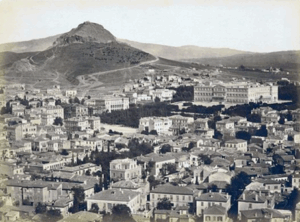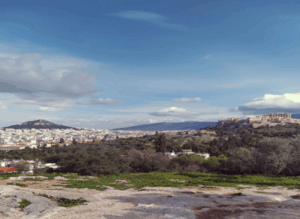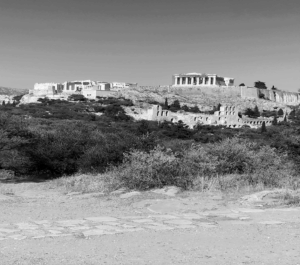Athens serves as a vital site of democratic heritage and urban evolution. Over the decades, its society and built environment have undergone a gradual but significant transformation. Like many historic cities, Athens faces complex challenges across social, economic, environmental, cultural, tourism, and security dimensions.
This blog explores initiatives focused on the preservation and development of Athens’ historic centre, particularly through the lens of tourism and cultural heritage. It examines how ancient sites and cultural institutions contribute to the city’s democratic identity and urban sustainability while offering a vibrant experience for both residents and visitors.
Travelling Back: History, Philosophy, and Culture
Athens holds a foundational place in the political and philosophical traditions of Western civilisation. The ideas introduced by ancient Greek thinkers, such as Plato, Socrates, and Aristotle, have profoundly shaped European intellectual history. Concepts such as autonomy, logic, and pragmatism continue to inform contemporary discourse.
Over the centuries, the city has undergone major historical and political transformations. Today, Athens remains central to Western identity within the broader European administrative and cultural framework. Its architecture and public policies have long emphasised the preservation of cultural heritage, particularly in the historic centre.
A notable example is the work of Melina Merkouri, twice Minister of Culture of Greece, who championed the preservation of the urban landscape surrounding the Parthenon and the Acropolis. Her efforts laid the foundation for today’s heritage policies, reinforcing these sites as enduring centres of historical knowledge and cultural exchange. Four decades later, these landmarks remain focal points of cultural continuity, symbolising Athens as a true crossroads of civilisation.


Urban Actions and Planning
Today, the Acropolis functions as both a symbolic and physical meeting point for locals and tourists. Within a five-kilometre radius, the area is home to a diverse array of social and cultural activities. Pedestrian-friendly routes offer a safe and engaging way to explore Athens, a journey that bridges its historical past and contemporary future.
Urban strategies for the development of Athens’ historic centre have evolved over several decades, shaped by both national policymaking and European Union integration. Since Greece entered the EU in 1981, the city’s economy has been significantly influenced by globalisation, particularly in the transportation and tourism sectors. These transformations have made Athens a modern pillar of democratic values and economic vitality. These broad planning strategies are reflected in the city’s evolving cultural landscape. The following sections examine key sites—including the Acropolis Museum, the neighbourhood of Plaka, and the often-overlooked Thissio Square- to illustrate how heritage preservation, tourism, and economic development intersect in the historic centre of Athens.

The original Acropolis Museum was established in 1865 and opened in a building on the archaeological site in 1874. Subsequent expansions took place in 1888 and after World War II to accommodate a growing collection of artefacts.
In the late 20th century, plans were initiated to build a larger, more modern facility away from the archaeological core. In response, a new 21,000-square-metre building was inaugurated in 2009 at the foot of the Acropolis. Designed by Swiss-American architect Bernard Tschumi, the museum remains a key institution in Athens’ cultural landscape (Parrott-Sheffer, C. 2024)
Plaka, the oldest known neighbourhood in Athens, is often considered the heart of the city’s historic centre. It extends along the lower northern and eastern slopes of the Acropolis and is roughly semicircular—about one kilometre in length and 350 metres in width (Zivas, D. A., 2010). With its narrow alleys, neoclassical architecture, and vibrant cultural life, Plaka provides an immersive historical experience while continuing to serve as a vital residential and commercial hub.
- Thissio Square: A Missed Opportunity
Thissio is among the most neglected districts in Athens’ historic centre. Since the 1800s, poor urban planning and the gradual abandonment of key infrastructure—such as the railway station and several surrounding buildings—have contributed to its decline (Zuppelli, S., 2019).
Yet, Thissio holds strong potential for economic and cultural revitalisation. Recommendations for its redevelopment include:
- Preserving the historical character of the area
- Protecting the natural beauty of the surroundings
- Enhancing security throughout the day, especially for tourists
- Restoring traditional land uses such as shops and small markets
- Introducing a modern smallholder market
- Creating cycling routes around Filopappou Hill
- Stimulating economic activity through food, entertainment, and recreational options.
These strategies could transform Thissio into a modern economic and tourist hub, with high aesthetic value, while safeguarding its cultural and historical identity.
- Cultural Icons and Literary Memory: Odysseus Elytis Museum
Odysseus Elytis studied law at the University of Athens. He became intrigued by French Surrealism, particularly the works of the poet Paul Éluard, and began publishing his poetry in the 1930s, notably in the magazine Nea Grammata. This publication served as a key platform for the “Generation of the ’30s,” an influential literary movement that included George Seferis, who would later become the first Greek Nobel Prize laureate in literature in 1963.
Elytis’s body of work—deeply shaped by Greek identity, philosophy, and modernist thought—remains an essential part of Athens’s cultural narrative. His poetic voice offers insight into how modern Greece sees itself through its historical legacy and creative expression.
The emphasis of the Pindaric injunction “learn what you are and become it” highlights the importance of becoming rather than merely learning. This is because the essence of humanity is already defined by the religion to which a person subscribes. According to Sherrard (1983), the crystallisation of Elytis’s poetry reflects a prismatic form that connects to the modernist metaphor of the poem as a crystal or precious stone. This relationship aligns with Elytis’s ideas about translucence, purity, and the transparency of the image. Koutrianou (1997) also addresses these themes in his analysis of Elytis’s work.
Conclusion: Towards a Cultural Future
Athens stands at the intersection of ancient heritage and modern challenges. The preservation of its cultural and historical legacy is essential not only for tourism and economic development but also for crafting responses to today’s pressing global issues—ranging from climate change and inequality to energy sustainability and human rights.
Cultural heritage plays a vital role in fostering community identity, civic engagement, and urban resilience. By honouring its past and investing in inclusive cultural development, Athens can continue to serve as a model for democratic, sustainable urban living—where history, economy, and humanity meet.
References
Koutrianou, E. (1997). The emergence and crystallisation of the poetics of Odysseas Elytis (Doctoral dissertation, University of Oxford).
Connect with the Author
Efthimios Georgiou is a professional whose multifaceted career encompasses urban planning, cartography, photography, and adult education. Based in Athens, Greece, he has made significant contributions to spatial planning, cultural heritage preservation, and geoinformatics.